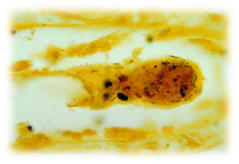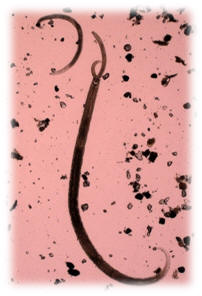Interactions with Other Species:
Domestic pigs interact every day with other organisms –the most
interesting and most prevalent being parasitism.
Parasitism is a destructive symbiotic relationship involving two organisms where
one organism is benefiting and the other is being harmed by the
relationship. Some of these parasitic relationships can cause mild
symptoms to severe symptoms and even death.
Atrophic rhinitis
Atrophic rhinitis (AR) is caused by the mycobacterium
Pasteurella multocidia. This
mycobacterium attacks the fine network of bones within the snout. AR
commonly appears in young piglets, because at this time the immune
system is not fully developed. The first signs of AR are sneezing and
rubbing snouts. Discharge may appear out of the nose and eyes. As
the infection continues pigs will commonly sneeze blood. AR can be
prevented by placing the pigs in a better environment. Keeping pigs
out of dust heavy environments should bring the levels of AR down.
Leptospirosis
 Leptospirosis is a reproductive disease cause by
Leptospira
bacteria. Leptospira commonly causes spontaneous abortions and the birth of weak
or stillborn piglets. The disease also can cause lowered milk production.
This can be treated with antibiotics. Lower-immune pigs become
infected when the bacteria enters through the mouth. The bacterium
travels to the kidney and quickly multiplies. The bacteria is then
spread to the urine and then taken up by other pigs that are in close
association.
Leptospirosis is a reproductive disease cause by
Leptospira
bacteria. Leptospira commonly causes spontaneous abortions and the birth of weak
or stillborn piglets. The disease also can cause lowered milk production.
This can be treated with antibiotics. Lower-immune pigs become
infected when the bacteria enters through the mouth. The bacterium
travels to the kidney and quickly multiplies. The bacteria is then
spread to the urine and then taken up by other pigs that are in close
association.
 Lice
Lice
Lice
are
very common in the domesticated pig. Pigs will rub and
scratch causing patches of fur to
be lost. Many treatments are available. Treatments should be
repeated every 12 days to ensure the termination of the lice
infestation.
Salmonellosis
The disease Salmonellosis results from infection with the bacterium Salmonella, which can be spread in a variety of ways. Pigs acquire this infection when coming in contact with infected feces. The domestic pig can also become infected if it comes into contact with infected food. The most common strain of Salmonella in pigs is Salmonella choleraesuis. This can lead to pneumonia and gut problems. The infection Salmonella choleraesuis can easily become septic and spread to important areas of the body.
To learn more about Salmonellosis click
here.There are several types of internal parasites that occur in the stomachs of domestic pigs.
These worms belong to the phylum Nematoda. The red stomach worm is most likely to be seen in pigs that are allowed to graze on an open pasture. The only sign of red stomach worm may be less weight gain than normal. This infection can also result in stomach ulcers.
The large round worm is most common however. The female round worms can lay over a million eggs per day. The eggs can be transported on the boots of farmers and are fairly resistant to disinfectants. The roundworms enter via the mouth and are transmitted from pig to pig through fecal matter. Taenia solium is a common pig flat worm - in fact it is called the "hog flatworm". T. solium use pigs as an intermediate host and live in a variety of pig tissues, most commonly the skeletal muscle.



